Table of contents
Oh, LinkedIn Ads are just too goddamn expensive!
How many times have you heard this—or even thought it yourself?
It’s a common complaint, and not without reason. LinkedIn’s premium targeting comes with premium costs, and for many businesses, it feels like they’re burning through budgets faster than they can generate meaningful leads.
But is it really LinkedIn Ads that are the problem? Or is it the way businesses are using them?
To find out, we partnered with Impactable and surveyed over 100 companies to find what’s working, what’s not, and how businesses are turning those high CPCs into even higher ROI.
We also hosted a live DBUG session in December 2024 where dozens of professionals gathered to discuss the survey insights. The live session featured four experts and delivered numerous insights.
Here’s what we found:
- Our Key Findings on How Companies Leverage LinkedIn Ads in 2024
- LinkedIn Ads Benchmarks for All Companies
- Are LinkedIn Ads Worth the Price? Here’s What Marketers Think
- 6 Proven Strategies to Maximize Your LinkedIn Ads ROI
- What’s Next for LinkedIn Ads in 2025 – Plans, Trends, and Insights
- Stay on Top of Your LinkedIn Ads Performance with Databox
Our Key Findings on How Companies Leverage LinkedIn Ads in 2024
To understand how businesses use LinkedIn Ads, we surveyed over 100 companies and outlined some key trends.
These insights shed light on the priorities, perceptions, and strategies driving LinkedIn Ads usage today.
For starters, most of the respondents we surveyed have 50 employees or less.
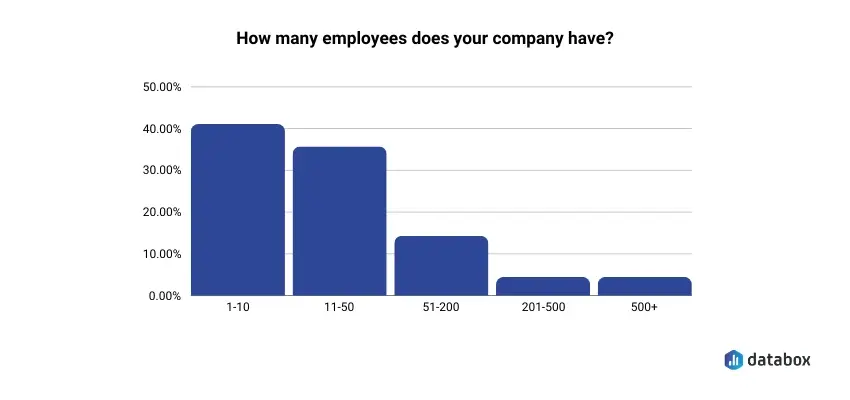
More than half of the respondents have been using LinkedIn ads for more than 2 years. This shows that businesses are committing to LinkedIn Ads long-term.
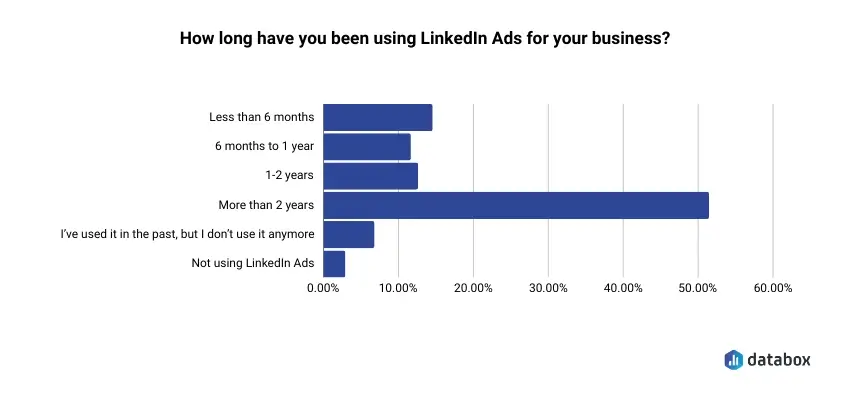
LinkedIn remains a top choice for generating high-quality leads, especially for B2B companies targeting niche markets – for about 70% of respondents, lead generation is the primary goal of their LinkedIn ads.
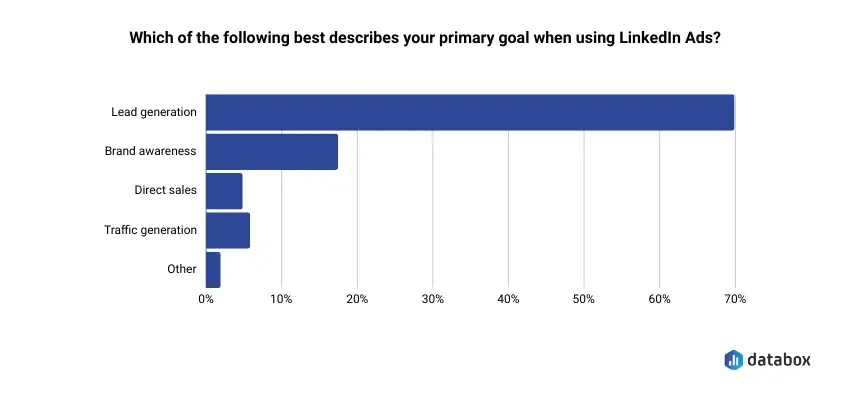
46% of respondents describe the performance of LinkedIn Ads compared to other advertising platforms they use as somewhat better.
LinkedIn Ads are seen as a competitive option, though there’s room for improvement when it comes to performance.
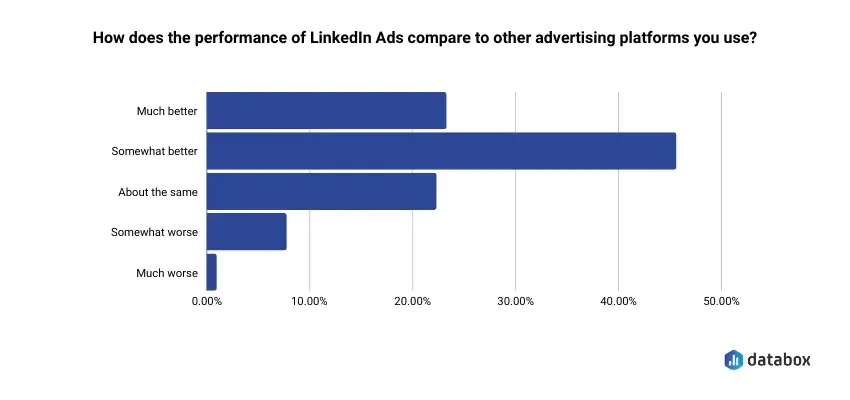
For about 40% of respondents, the budget for LinkedIn Ads is bigger than that for other advertising platforms.
LinkedIn’s cost premium reflects its specific advantages, particularly in terms of targeting professional audiences.
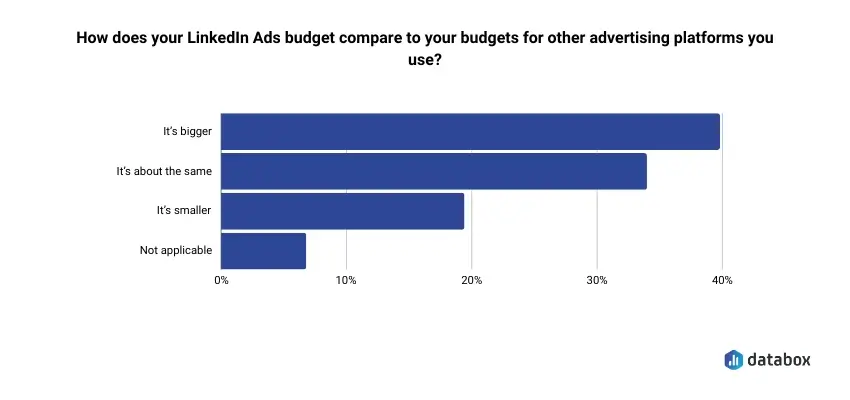
Most companies we surveyed think that LinkedIn Ads are moderately cost-effective.
This is in line with the perception that while LinkedIn Ads may come at a higher cost, they deliver sufficient value to justify the expense for many businesses.
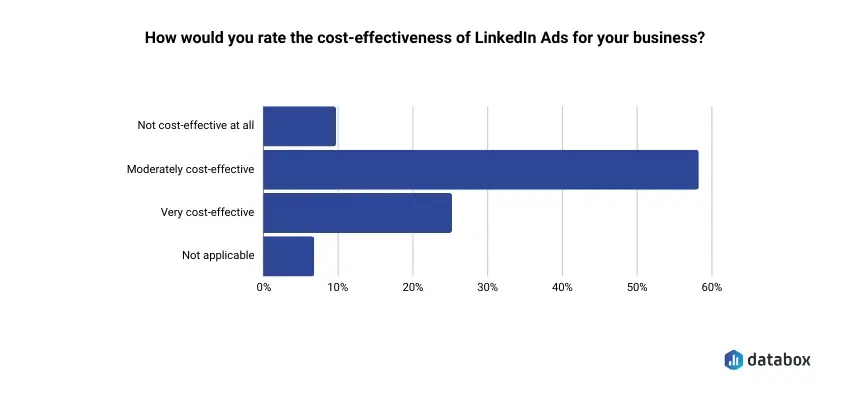
The top-rated factor that influences the perception of the cost of LinkedIn Ads the most is conversion rates (selected by 28% of the respondents). Target audience specificity and cost per click (CPC) follow closely.
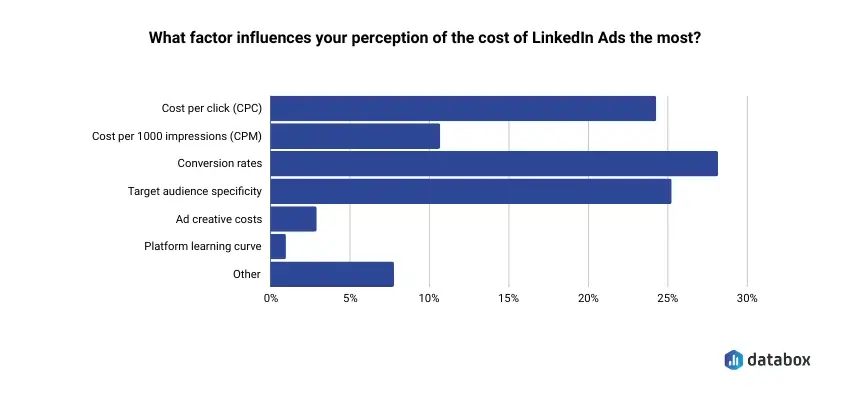
The best-rated aspect of LinkedIn Ads is targeting options. This underscores LinkedIn’s strength in helping businesses reach the exact decision-makers they need.
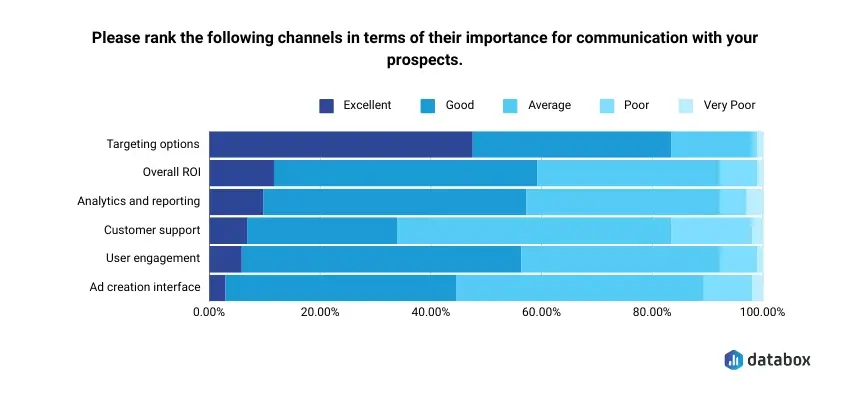
Lastly, we wanted to know whether LinkedIn Ads strikes a fair balance between cost and the results they deliver.
We found that 2/3 of the respondents think that LinkedIn Ads are reasonably priced considering the value they provide.
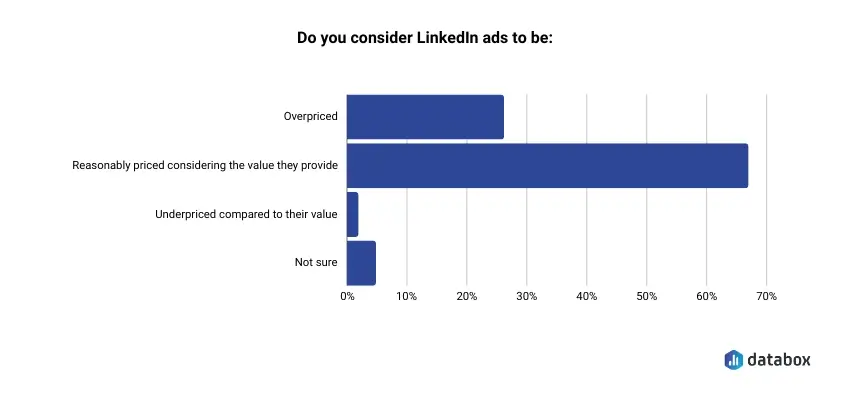
LinkedIn Ads Benchmarks for All Companies
To provide a broader perspective on LinkedIn Ads performance, we’ve analyzed data from the Benchmark Group LinkedIn Ads Benchmarks for All Companies.
Our product aggregates insights from over 400 marketers to provide companies with valuable benchmarks to help evaluate their own campaigns.
According to data provided by LinkedIn Ads Benchmarks for All Companies, the average CPC in November 2024 was $5.78 (median, 398 contributors).
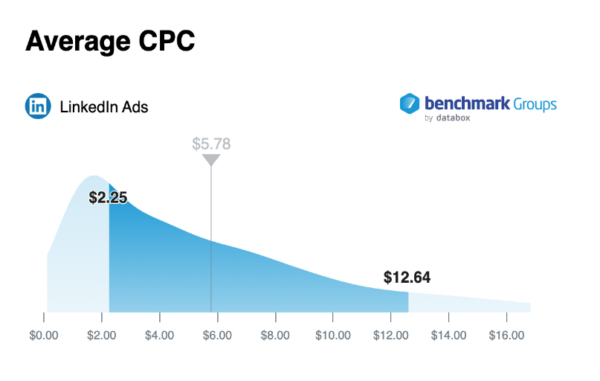
During our DBUG session, Maninder Paul said that this was interesting because “with the cost per click at 5, it’s slightly surprising for me because I’ve seen the cost can be around 8.8 dollars or so.”
“I think the cost per click could be relatively lower only when we’ve run certain campaigns on the awareness and engagement side because then so it sort of lowers it. It’s because LinkedIn can capture that you’ve been running ads not only from the lead’s perspective, but you’re in here for a longer game, and also, organic plays a huge influence in whatever we do.”
In that same period, reach was 12.82K (median, 34 contributors). This shows LinkedIn’s success in reaching professional audiences, even with smaller campaign budgets.
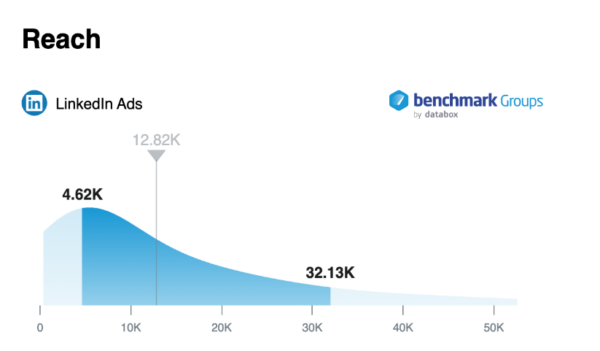
Median spend during November 2024 was $1.39K (346 contributors).
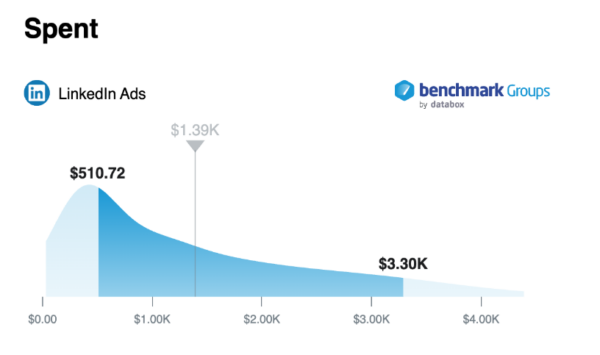
If you’re running LinkedIn Ads and want even more actionable insights into other metrics, you can join our free Benchmark Group LinkedIn Ads Benchmarks for All Companies.
By joining, you’ll be able to anonymously compare your LinkedIn Ads performance with other similar companies at no cost.
All it takes is connecting your account to the group—completely anonymous and secure. You can even create your own Benchmark Group, giving you full control over who accesses it and shares data.
Whether LinkedIn is your primary channel or part of a broader marketing mix that includes platforms like Facebook Ads or Google Ads, the Benchmark Groups product can help you find relevant performance data and spot areas to optimize across your campaigns.
Are LinkedIn Ads Worth the Price? Here’s What Marketers Think
Marketers often find themselves at a crossroads when deciding whether LinkedIn Ads are worth the premium price tag.
To better understand the value of LinkedIn Ads, we spoke to marketers who’ve used the platform extensively and asked them to share their experiences, results, and advice.
Here’s what they revealed:
- Depends on How You Measure Its Value
- LinkedIn Ads Work for Specific Industries
- You Need a Well-Crafted Strategy to Make It Work
- LinkedIn Leads Are Already Sales-Qualified
- LinkedIn Is the Best PPC Platform for Professional Targeting
Depends on How You Measure Its Value
When it comes to the cost of LinkedIn Ads, the answer isn’t black and white—it depends on how you measure value.
For some, the high CPC or CPM rates can make LinkedIn Ads feel expensive. But for others, the platform’s ability to deliver high-quality leads outweighs these costs.
Gökhan Coskun of Mochatouch GmbH puts it like this:
“Is LinkedIn Ads Expensive? The answer depends on the perspective from which you evaluate it. The concept of “expensive” is inherently subjective and varies depending on factors like the advertiser’s budget, industry, product, and competition.
So I think we should reframe the question:
-Are LinkedIn Ads expensive from a CPM or CPC perspective? Yes, compared to other platforms, LinkedIn Ads often cost more upfront.
– Are LinkedIn Ads expensive when evaluated based on cost per acquisition or return on investment? No, as they typically deliver better-qualified leads and higher conversion rates.”
LinkedIn Ads Work for Specific Industries
Choosing the right platform for advertising often boils down to the nature of your audience and campaign objectives.
For B2B marketers, LinkedIn’s strength lies in its precise targeting of professionals and decision-makers. But this comes at a cost—higher CPCs and a more passive audience compared to intent-driven platforms like Google Ads or Bing Ads.
For example, a SaaS company promoting enterprise software might find LinkedIn invaluable for reaching C-level executives.
On the other hand, a company selling IT solutions to small businesses could achieve better ROI through Google Ads, where users are actively searching for specific solutions.
Ryan Doser of Empathy First Media talked about how LinkedIn Ads are overpriced, but they may work for specific industries:
“When it comes to B2B high ticket lead generation, I do believe LinkedIn Ads have value in several industries. However, based on results we are seeing for our current lead gen clients I can’t justify allocating more ad spend on LinkedIn than Google Ads or Bing Ads.
For our clients, LinkedIn’s higher CPCs don’t deliver the ROI we are getting from Google or Microsoft. Advertising on search engines is also more “intent-focused” compared to LinkedIn.”
Kamel Ben Yacoub of Getuplead also shared some specific examples to demonstrate when LinkedIn could be a good option:
“Are LinkedIn Ads “too expensive”? It’s all about the ROI. If you are a B2B business targeting white collar working in a specific vertical (manufacturing, education, IT, etc.) and your LTV (Lifetime value) is > $3000, it’s definitely worth the test. For example, if your average customer LTV is $10,000, you’ll find very cheap to pay $500 for a sales-qualified demo.
On the other hand, if your average monthly revenue per user is $50 with an LTV of $500, paying $500 for a demo is not at all interesting for your business, you are wasting money.
Keep in mind the cost per click is significantly higher than any other social media platforms like Meta or Reddit but with LinkedIn, you can be very specific about your targeting ensuring that only your ideal customers are getting hit with your ads. On Facebook or Reddit you’ll pay less per click but reach a much broader audience, wasting money on people who aren’t part of your ideal customer profile.”
You Need a Well-Crafted Strategy to Make It Work
LinkedIn Ads demand a high level of precision. With cost-per-click rates often exceeding $5–$10, simply running generic campaigns won’t cut it.
Companies need a well-crafted strategy with a hyper-targeted approach, starting with clear campaign objectives. You also need to pair your targeting with a deep understanding of your audience’s decision-making process.
What truly separates successful campaigns from lackluster ones isn’t just the platform itself—it’s the strategy behind the ads.
Luiz Bernardo of Prosperidade Conteúdos explained how “the efficiency of campaigns depends on a well-crafted strategy, including a clear definition of the target audience, creation of relevant content, and continuous monitoring of results for necessary adjustments.”
“Additionally, the integration of technologies such as Artificial Intelligence and Machine Learning has enhanced paid media, enabling more accurate analysis and campaign optimization, increasing return on investment.”
Diego Oquendo of SaaS Academy also talked about how your targeting, creative, and funnel strategy play a major part:
“LinkedIn has the strongest audience targeting options for B2B companies and when done right, this can be the number 1 place companies should be going to advertise their products and services. But, ad platforms are as effective as you wish them to be, you can choose any platform that you’d like, but if your audience targeting, creative, offer, and/or funnel is not properly optimized, no channel will make your ads work.
Costs-wise, LinkedIn often has higher CPMs in comparison to other channels, but it comes for a good reason, it gives you strong flexibility to target companies and potential customers based on almost any criteria that you’d wish to use. So unless you have a strong grasp of your offer, audience, and messaging, this can be either your best or your worst channel!”
PRO TIP: Want an easier way to track your LinkedIn performance? You can download our free LinkedIn Ads Overview Dashboard to compile all of your most relevant metrics and KPIs in one centralized location, where you can instantly track performance and see how your campaigns are doing. No more juggling LinkedIn’s confusing spreadsheets.
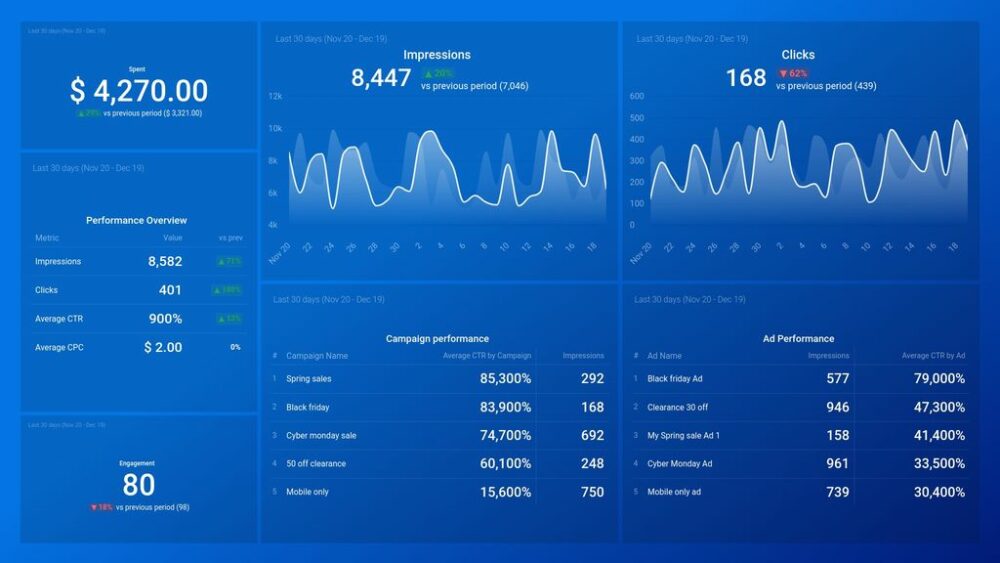
LinkedIn Leads Are Already Sales-Qualified
You also need to consider the quality of the leads generated from LinkedIn Ads.
For many businesses, LinkedIn’s ability to deliver sales-qualified leads directly to the pipeline justifies the higher upfront costs.
Unlike platforms that focus primarily on building awareness or driving clicks, LinkedIn often attracts professionals actively seeking solutions, making the transition from lead to conversion much smoother.
This can significantly reduce the cost per acquisition over time, as fewer resources are spent on nurturing unqualified leads.
Nayan Prakash of YAMU Media is one of our respondents who talked about this:
“I’ve been using LinkedIn Ads for over three and a half years, so I’ve gained a solid understanding of how this platform works. My primary goal is lead generation, and I find LinkedIn to be somewhat better than other social platforms in this area, thanks to its professional audience and precise targeting.
My budget for LinkedIn Ads is about the same as what I spend on other platforms, and I’d rate it as moderately cost-effective. While the costs can be higher, the quality of leads often justifies the investment, as the leads we receive are already qualified based on the audience we target through ads.
The factor that most influences my perception of cost is LinkedIn’s ability to target niche audiences. The targeting options are excellent, and the ad creation interface is very user-friendly (without the unnecessary complexities of other social platforms). However, there’s room for improvement in areas like customer support, particularly in addressing quick queries, and overall ROI, which I’d rate as good rather than outstanding.
Overall, I consider LinkedIn Ads reasonably priced for the value they provide, especially for reaching the right audience with precision. The leads we get from LinkedIn are already sales-qualified, which further justifies the cost.”
LinkedIn Is the Best PPC Platform for Professional Targeting
LinkedIn offers a level of targeting precision that’s unmatched by other PPC platforms.
Whether you’re zeroing in on C-suite executives in healthcare, IT decision-makers at mid-sized companies, or senior marketers in Fortune 500 firms, LinkedIn allows you to refine your audience based on job title, company size, seniority, industry, and even specific skills.
This capability is a major benefit for B2B campaigns. While the CPC may be higher, the ability to reach these decision-makers directly often results in higher conversion rates.
“There is a perception of LinkedIn Ads being overpriced due to the metrics. In the professional space, you really can’t compare LinkedIn to any other platform.
Each advertising platform has its value and purpose, but in B2B or B2C based on professional targeting, LinkedIn is the best. I’ll break this down further. LinkedIn is undoubtedly the largest Professional Social Media platform in the world with over 1 Billion users. It’s a social space made and used by professionals. It also has the most up-to-date professional data than any other platform.
What do people do when they lose or change jobs? Update LinkedIn. So it has the best professional data. LinkedIn is powerful because it provides comprehensive filters so that you can target the decision-makers and influencers that you know are best for your offer. There is NO other platform that has filters like this or such current data.”
Want to get highlighted in our next report? Become a contributor now
Nemanja Djakovic also says that there are “very few places where you can target such a specific niche as effectively as you can on LinkedIn.”
“With LinkedIn, you can open doors that would otherwise remain shut—or that you might not even know existed.
Do you have a SaaS solution in finance tailored for small and medium-sized businesses in the HoReCa segment? LinkedIn has you covered. Building highly specific robotic arms for yachts to lift small boats out of the water? We’ve got you.
Need to find spare parts from Toyota car dealerships in Kenya, Zambia, and Senegal? Easy. Selling high-end luxury condos on the Adriatic coast? Looking for leads for an MBA program with candidates who have five years of managerial experience and a bachelor’s degree? Done. Selling highly complex HVAC systems for industries and hotels? We’ve got you covered.
These kinds of targeting capabilities are hard to find anywhere else.”
6 Proven Strategies to Maximize Your LinkedIn Ads ROI
LinkedIn Ads ROI isn’t about spending more – it’s about spending smarter.
From zeroing in on decision-makers to crafting ads that actually grab attention, the right strategies can transform your campaigns from mediocre to amazing.
Let’s check out some proven strategies our respondents use that you can apply to your own campaigns:
- Start with Awareness And Work Your Way Down the Funnel
- Run A/B Tests Frequently
- Run a Lead Gen Campaign with Quality Content and Then Use Retargeting
- Test Your Ads on Google or Meta and Then Run the Winners on LinkedIn
- Run Ads to Custom Audiences
- You Need Good Copywriting
Start with Awareness And Work Your Way Down the Funnel
LinkedIn can support campaigns across every stage of the funnel, but jumping straight to conversion-focused ads without building awareness can sometimes limit your success.
For some companies, it’s better to start by creating top-of-funnel campaigns that focus on brand awareness and audience engagement.
Use these campaigns to educate your target audience and build trust. Sponsored content and video ads are excellent tools for this stage.
Once you’ve established awareness, you can transition into middle-of-funnel campaigns to nurture interest. This could include promoting case studies, whitepapers, or webinars.
Finally, move to bottom-of-funnel campaigns that focus on lead generation or direct conversions using tools like Lead Gen Forms or Conversion Ads.
“Although more costly in the beginning, unlike Meta Ads, LinkedIn Ads are a long run. I’ve always considered that it is the only ad platform where it is crucial to start with Awareness (both Ads and Organic), and work your way further down the funnel.
Catch their eyes with quality (e.g. carousel) content, get it in front of them with precise and high-intent targeting, and work them all the way down to registration or a booked call.”
Want to get highlighted in our next report? Become a contributor now
Run A/B Tests Frequently
With LinkedIn’s advanced targeting, small tweaks to your campaigns can have a major impact on performance, and A/B testing helps you zero in on what works best.
Start by testing specific elements of your ads, such as headlines, ad copy, visuals, or CTAs.
For example, you could compare a direct, benefit-focused headline with a curiosity-driven one to see which resonates more with your audience.
Similarly, experiment with different ad formats, like Sponsored Content versus Video Ads, to determine which gets more engagement for your specific goals.
Don’t stop at the ad level. Test audience segments to refine your targeting further. You could compare the performance of ads targeting senior managers versus C-suite executives or different industries to uncover where your budget delivers the highest ROI.
As Chris McDermott of Intercoastal Consulting & Life Care Planning puts it, you should “conduct A/B testing on different ad variations to identify what resonates best with your audience. Test various headlines, visuals, ad formats, and calls-to-action to refine your approach and optimize for higher engagement.”
Lukas Holschuh also talked about how important testing is:
“We usually run continuous split-testing of campaign objectives (native lead form ads versus website conversions, versus lead magnets, versus retargeting), of targeting options (broader versus more specific ICPs), and creative (images, videos, carousels, etc.). We then turn off everything that doesn’t perform well over time to allocate more ad spend to the winners.”
PRO TIP: With our free LinkedIn Ads Performance Overview Dashboard, you can easily track how each of your ads performs on a granular level. You can monitor everything from reach to CTR and CPC in one place, in real-time.
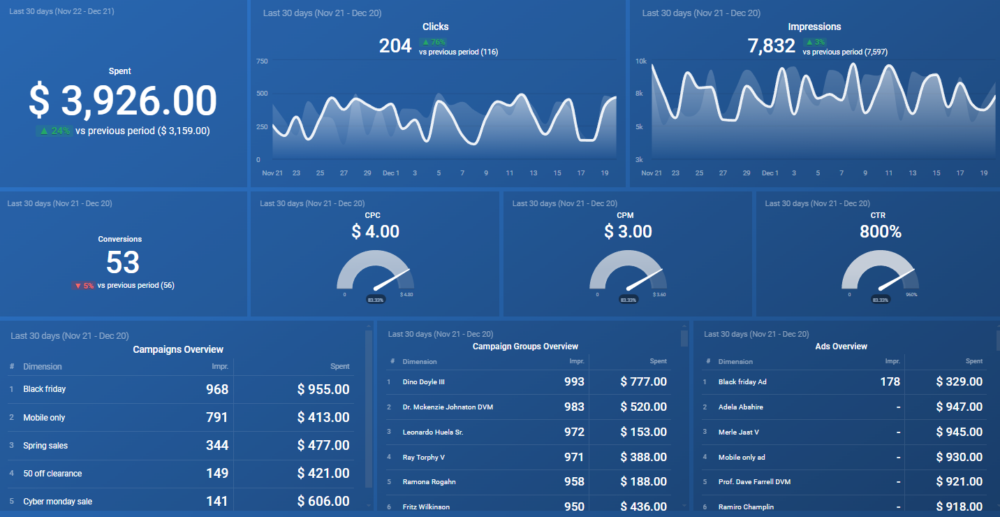
Run a Lead Gen Campaign with Quality Content and Then Use Retargeting
Another strategy for LinkedIn Ads is to combine quality content with a well-planned retargeting strategy.
You can start by offering something of real value to your audience, such as a whitepaper, eBook, webinar, or case study, through a lead generation campaign. Lead Gen Forms make it easy for users to submit their information without leaving the platform.
For example, if you’re targeting HR professionals, a guide on improving employee retention could resonate well.
Once you’ve collected leads, use retargeting to keep your brand top of mind and guide them further down the funnel.
Retargeting ads could focus on product demos, customer testimonials, or limited-time offers to drive conversions.
Devin Littlefield of Market Vantage talked about how “the strategy we’ve seen work exceptionally well is a great Lead Gen campaign for a well-created piece of content that targets the right ICP/buyer persona, and then a retargeting campaign getting people to take a specific action (demo, product tour, consult, etc.).”
“This simple two-campaign strategy will generally be able to produce cost-effective MQL/SQL volume and then drive bottom-of-funnel action at a relatively low cost. The biggest consideration here is making sure your product/service/offer is a big enough of a purchase to justify the expense (i.e. if you have a $15K/year+ product or service).”
During our DBUG session, Joshua Stout also went into detail about how a lot of companies make mistakes with retargeting:
“What’s important and what I see a lot of companies miss is they don’t have audiences in place to retarget that engagement. Because if somebody clicks and you expect them to convert in that first touchpoint, it won’t work. I never do that and I don’t know if any of you do. If you ever see it, oh, this is interesting. Let me go give them my info right now and schedule a demo.
I’m usually perusing LinkedIn in the middle of calls or something. I’m definitely not going to schedule a call. But once they continued, they showed that interest. They saw your message. They’re interested. Now you have to establish your credibility. Don’t drop them off there. Now’s the time we have to stay in front of them, show them your content, mix in your thought leader ads, boost that in front of them, and ultimately educate them on why you’re the best choice for them to make, and earn that call.
Earn that demo. But I guarantee you what you’re going to see is in those retargeting campaigns, your cost per click is going to be much lower.”
Aaron Eaves agreed and added that “you spend so much money getting in front of these people, and then a lot of most of the times, no one wants to follow up with that little retargeting piece and close that loop.
LinkedIn is fantastic for that. It’s expensive, but your retargeting is not going to be as expensive. You spend a lot of money getting in front of them. That’s going to be your best and most efficient cost per click, usually.”
Test Your Ads on Google or Meta and Then Run the Winners on LinkedIn
One cost-effective strategy is to test your ads on these lower-cost platforms first and then use the top-performing creative for LinkedIn campaigns.
Platforms like Google Ads or Meta Ads are ideal for experimentation due to their lower CPCs and faster feedback loops.
You can begin by running A/B tests on ad copy, visuals, and CTAs, to track which combinations generate the most engagement or conversions.
Once you’ve found the best-performing ads, you can adapt them for LinkedIn. Just keep in mind that LinkedIn’s professional audience may require slight adjustments to tone or messaging.
Gail Gardner of GrowMap said that his best advice is to “test your ads at either Google search or Facebook, whichever is less expensive.”
“Then test them on the other platform. Only after you have winning ads that convert well should you then use them on LinkedIn. It is also essential to continually monitor and adjust any ads you have running. Stop those that aren’t working quickly.
Adjust your targeting and continually monitor your progress. And always start your ad spend conservatively! Starting with a clear strategy is essential to success. That should include using the attributing and tracking parameters to more effectively measure ROI. LinkedIn ads do work best for B2B marketing.”
Run Ads to Custom Audiences
Custom audiences help you refine your targeting with more than just generic parameters.
You can leverage LinkedIn’s matched audiences feature, where you can upload lists of email addresses, company names, or contact data to target users already in your CRM.
This means you could run a campaign targeted at re-engaging past leads or upselling current customers with a new product.
You can also create custom audiences based on website activity. Using LinkedIn’s Insight Tag, you can track visitors to specific pages on your site and retarget them with ads that fit their interests.
Ryan Doser of Empathy First Media explains how “using highly qualified audiences in your targeting is very important to maximize ROI.”
“Our most successful campaigns on LinkedIn Ads have come from using custom audiences. These audiences are comprised of previous website visitors (remarketing) and those who have signed up for previous webinars.”
You Need Good Copywriting
Even the most precisely targeted campaign can fall flat if the copy doesn’t resonate with your audience.
Good copywriting not only grabs attention but also communicates your value proposition clearly and drives users to take action.
Remember to test different styles—formal, conversational, or benefit-focused—to see what resonates best.
“Persuasive ad copy is an underutilized strategy that can significantly improve campaign performance.
But here’s the truth – it’s not quick. It takes time and effort because it’s not just about grabbing attention—it’s about guiding the reader to take action and convert. Some people are shocked when I tell them I’ll listen to two hours of podcasts on the topic I’m writing about or conduct 4 to 5 one-on-one interviews with clients who’ve used the product or service—before writing a single line of copy.
But that’s exactly how I ran ads for a webinar that brought in sign-ups at just $4.40 and ROAS of nearly 300%. The alternative? I’ve seen companies come to me for help because their ads cost $50 per click or because they’ve spent $5,000 on LinkedIn ads without generating a single lead. LinkedIn ads can be expensive—but only if they’re done poorly.”
Want to get highlighted in our next report? Become a contributor now
What’s Next for LinkedIn Ads in 2025 – Plans, Trends, and Insights
With advanced targeting options, AI-driven optimizations, and new ad formats, LinkedIn Ads are preparing to bring some major changes in 2025.
Here’s what you need to know to future-proof your LinkedIn Ads strategy and what our respondents plan to do:
- Start Running More Video Ads
- Increase the Budget for LinkedIn Ads
- Build a Stronger Full-Funnel Strategy
- Experiment With the New Predictive Audience Feature
- Test New LinkedIn Functionalities
- Customize Campaigns Based on the Audience Region
Start Running More Video Ads
Video content can help your brand tell a story, showcase products in action, or share testimonials—all while capturing the attention of busy professionals scrolling through their feeds.
Often, a well-crafted 30-second video with a solution to a common industry problem can generate more interest and clicks than a static image ad.
While LinkedIn is still new to reels and videos compared to some other platforms, this trend will probably get more popularity soon.
Gourav Rao of Adounce says that their “future plan is to run video ads because I noticed that LinkedIn has introduced a Reels-like feature. I can use it to show a video message encouraging my audience to fill out the form.”
Increase the Budget for LinkedIn Ads
More businesses are starting to see strong results from LinkedIn, so increasing the ad budget in 2025 could be a smart move to stay competitive.
This doesn’t mean just throwing more money into campaigns – focus on what’s already working for you.
Use data from past campaigns to identify what’s working, whether it’s targeting specific industries, promoting lead magnets, or running account-based marketing (ABM) campaigns.
A bigger budget also gives you the flexibility to try new ad formats or features LinkedIn rolls out, like interactive content or more advanced retargeting tools. You’ll have more room to experiment and drive results without wasting spend.
Bhavik Sarkhedi of Content Whale is one of our respondents who plan to do this:
“Our future strategy for LinkedIn Ads involves reallocating more budget towards them, especially in light of the higher CPC we’re facing with Google Ads. The decision is based on LinkedIn’s superior targeting capabilities within the B2B sector, which we believe can yield higher quality leads and better conversion rates.
This shift doesn’t mean abandoning Google Ads but optimizing our ad spend to tap into each platform’s unique advantages. Essentially, we’re betting on LinkedIn’s targeted environment to offer a more cost-effective approach for our specific marketing objectives.”
Build a Stronger Full-Funnel Strategy
A full-funnel strategy is all about creating a seamless journey for your audience, so you can guide them from the first touchpoint to the final conversion.
Instead of focusing solely on lead generation or sales, this approach considers every stage of the buyer’s journey—awareness, consideration, and decision.
For LinkedIn Ads specifically, a full-funnel approach is crucial because the platform excels at reaching professional audiences at various levels. Without it, you risk either overwhelming cold prospects with sales pitches too soon or failing to convert warm leads because they weren’t guided effectively.
Gökhan Coskun of Mochatouch GmbH explained how they “plan on building a strong full-funnel strategy; not just tactical campaigns.”
“This is because LinkedIn excels at mid-to-bottom-funnel activities, particularly for high-ticket B2B services and niche audiences. My plan is also to focus on tracking MQL-to-SQL conversion rates to validate lead quality and testing different messaging and targeting to fine-tune and refine cost-per-acquisition (CPA).”
Experiment With the New Predictive Audience Feature
This new feature uses machine learning and data insights to outline audiences most likely to engage with your ads (or convert).
Traditional targeting usually relies on demographic and job-related filters, which are effective but can sometimes miss nuances in audience behavior.
Predictive Audience goes a step further and analyzes past campaign performance, user behavior, and platform data to suggest high-potential segments you might not have considered.
Matthew Engelson of Sagefrog Marketing Group plans to use this new feature going into 2025:
“Our future plans continue to involve LinkedIn advertising by taking advantage of the new predictive audience feature to grow our clients’ audiences since we are in the small to medium size B2B space.”
Test New LinkedIn Functionalities
Predictive analytics isn’t the only feature LinkedIn is working on.
During the DBUG session, Nico Kusterer talked about another new feature that LinkedIn is releasing and explained how he plans to use it:
“There’s a very interesting feature that LinkedIn just launched that enables us to see every single company that has seen our ads and you got a whole list of them. For example, you can open it and say, show me all the companies that have seen my ads in the past 90 days. Then, you can filter by campaign, number of paid clicks, or something similar, and create a list of high-intent accounts.
So that is something that was always invisible before because we were not really able to see every company. That was just, like, the top 20 or 25 list, and so that’s very helpful to get us lots of insights even before generating a lead, and identifying high-intent accounts, and we can also save these lists as ABM targeting lists for our campaigns.
Basically, they are updating themselves with the new companies that come in, fulfilling the criteria that we set as filters. Unfortunately, it’s just company-level. Contact level would be awesome, but due to data privacy, it’s impossible.”
Customize Campaigns Based on the Audience Region
The cost per conversion can vary a lot depending on the region you’re targeting.
Some regions deliver conversions at a fraction of the cost, while others demand a much higher investment.
Focusing on regions with lower costs per conversion lets you stretch your budget further and get better results.
For regions where conversions cost more, the challenge is usually figuring out the best approach—whether that’s narrowing your audience, tweaking your messaging, or trying different ad formats.
Stefania Borchia of Featurespace explained how they plan to implement this going forward:
“Since there is a wide cost/conversion among regions, the plan is to focus on regions where the cost/conversion is low (below £30) and come up with new campaigns for regions where the cost/conversion is higher (above £100). The challenge is to find the right campaign for each region.
That means defining a target audience that the company is interested in and finding the right product/offering for such an audience. The closer the gap between the audience and its challenges, the easier will be to create a campaign that resonates with such a market segment.”
Stay on Top of Your LinkedIn Ads Performance with Databox
Not seeing the results you want from your LinkedIn Ads? You’re not alone.
The secret to making them work isn’t just about running campaigns—it’s about knowing how they’re performing, what’s working, and where you can do better.
Without clear insights, it’s easy to waste money on ads that don’t deliver.
That’s where Databox comes in.
With Databox Dashboards, you can bring all your LinkedIn Ads metrics together in one centralized, real-time dashboard.
No more jumping between platforms or digging through spreadsheets. Track click-through rates, conversions, cost-per-click, and ROI all in one place.
With 130+ integrations, Databox also connects your LinkedIn Ads data to tools like HubSpot, Google Analytics, and Facebook Ads, so you can get a complete picture of your marketing performance.
And it doesn’t stop there. You can also use our LinkedIn Ads Benchmark Group to compare your performance against other businesses in your industry.
See if your ads are delivering competitive results or if there’s room to optimize further. You’ll get instant access to benchmarks like average CPCs and conversion rates, so you can refine your strategy with confidence.
It’s time to stop guessing and start knowing.
Sign up for a free Databox trial today, and see how easy it is to take control of your LinkedIn Ads performance.
















